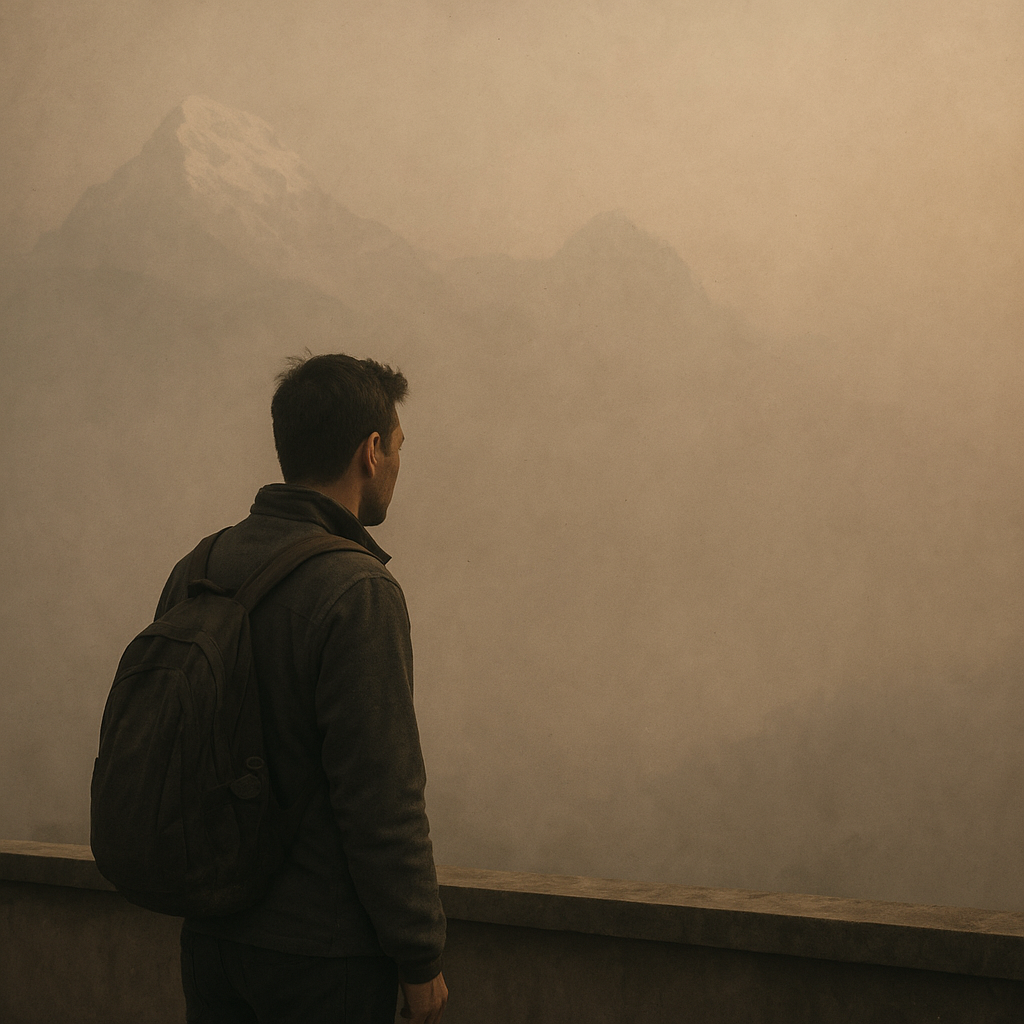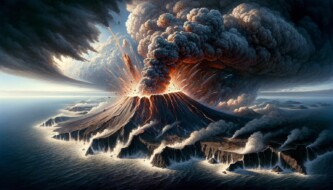The majestic Himalayas, known for their breathtaking beauty, are becoming increasingly difficult to see due to severe air pollution. Growing up in Kathmandu, I always cherished the panoramic views of these towering peaks. However, during my recent visits, I found that haze often obscured the mountains, even during the traditionally clear spring and autumn months. On one occasion, my flight had to circle Kathmandu multiple times before landing due to poor visibility caused by haze. Despite staying at a hotel with a good view, I was unable to see the mountains during my entire two-week visit.
The haze in the region is primarily caused by a combination of pollutants, including dust and smoke from various sources. Scientists have noted that these hazy conditions are becoming more intense and lasting longer, significantly reducing visibility. Traditionally, the best times for trekking in the Himalayas were from March to May and October to November, when skies were clear. However, rising temperatures and worsening air quality have led to thick haze during these months, diminishing the chances of seeing the mountains.
This decline in visibility has serious implications for the local tourism industry. Trekking guide Lucky Chhetri reported a 40% decrease in business due to the haze, which has left many operators feeling despondent. Tourists, like Australian visitor John Carrol, have expressed disappointment at not being able to see the mountains as they once could. The Trekking Agents Association of Nepal has indicated that many trekking operators are considering changing professions due to the lack of business stemming from poor visibility.
On the Indian side of the Himalayas, tour operators have also noted that haze is returning more quickly and is denser than in the past. Malika Virdi, who runs a community tourism business in Uttarakhand, mentioned that the weather patterns have changed, leading to prolonged periods of haze. In contrast, the western Himalayas in Pakistan have experienced less haze, but even there, locals report that the mountains are not as visible as they used to be. The persistent haze has become a significant concern for both tourists and those working in the tourism sector.
The air pollution affecting the Himalayas is a result of various factors, including vehicular emissions, industrial activity, and agricultural practices. The increase in forest fires and the burning of crop residues further contribute to the problem. Experts warn that the trend of increasing haze and dust storms in South Asia is likely to continue due to climate change. As a result, the stunning views of the Himalayas may soon be relegated to photographs and postcards, leaving those in the tourism industry grappling with the challenge of providing experiences that meet visitor expectations.
Original news source: Why the mighty Himalayas are getting harder and harder to see (BBC)
🎧 Listen:
Slow
Normal
Fast
📖 Vocabulary:
| 1 | majestic | Having a grand and impressive beauty |
| 2 | obscured | Hidden or made difficult to see |
| 3 | pollutants | Harmful substances that contaminate the environment |
| 4 | visibility | The ability to see or be seen |
| 5 | implications | Possible effects or consequences of an action or decision |
| 6 | despondent | Feeling hopeless or in low spirits |
| 7 | disappointment | A feeling of dissatisfaction or sadness due to unmet hopes |
| 8 | prolonged | Extended in duration or time |
| 9 | emissions | Substances released into the air, often from vehicles or factories |
| 10 | residues | Remnants or leftovers, often from a process or activity |
| 11 | contribute | To help cause or bring about a result |
| 12 | trend | A general direction in which something is developing or changing |
| 13 | relegated | Assigned to a lower or less important position |
| 14 | grappling | Struggling to deal with or overcome a challenge |
| 15 | expectations | Beliefs or hopes about what will happen in the future |
Group or Classroom Activities
Warm-up Activities:
– CHARADES
Instructions: Students will take turns acting out words or phrases related to the article (e.g., “Himalayas,” “pollution,” “trekking”). The rest of the class will guess the word or phrase being acted out. This helps reinforce vocabulary in a fun and engaging way.
– OPINION POLL
Instructions: Divide the class into small groups and ask them to discuss their opinions on the impact of air pollution on tourism in the Himalayas. Each group will then share their main points with the class, allowing for a broader discussion on environmental issues and tourism.
– HEADLINE CREATION
Instructions: Students will be tasked with creating catchy headlines for the article. They should think creatively and consider what aspects of the article are most newsworthy. Once created, students can share their headlines with the class and discuss the reasons behind their choices.
– MIND MAP
Instructions: In pairs, students will create a mind map that outlines the main points of the article. They should include causes of air pollution, effects on tourism, and potential solutions. Afterward, pairs can present their mind maps to the class for further discussion.
– TWO TRUTHS AND A LIE
Instructions: Each student will come up with two true statements and one false statement related to the article’s content. They will share these with the class, and the other students will try to identify which statement is the lie. This activity encourages comprehension and critical thinking.
🤔 Comprehension Questions:
1. What personal experiences did the author share about their views of the Himalayas while growing up in Kathmandu?
2. How has air pollution affected the visibility of the Himalayas during traditionally clear months?
3. What specific pollutants contribute to the haze in the region, according to the article?
4. What impact has the haze had on the local tourism industry, particularly for trekking guides?
5. How has the experience of tourists visiting the Himalayas changed in recent years, as mentioned in the article?
6. What differences in haze conditions have been observed between the Indian and western Himalayan regions?
7. What are some of the factors contributing to air pollution in the Himalayas, as discussed in the article?
8. How do experts predict climate change will affect the visibility of the Himalayas in the future?
Go to answers ⇩
🎧✍️ Listen and Fill in the Gaps:
The majestic (1)______, known for their breathtaking beauty, are becoming increasingly difficult to see due to severe air pollution. (2)______ up in Kathmandu, I always cherished the panoramic views of these towering peaks. However, during my recent visits, I (3)______ that haze often obscured the mountains, even during the traditionally clear spring and autumn months. On one occasion, my flight had to circle Kathmandu (4)______ times before landing due to poor visibility caused by haze. Despite staying at a hotel with a good view, I was unable to see the mountains during my entire two-week visit.
The haze in the region is primarily caused by a combination of pollutants, including dust and smoke from various sources. Scientists have noted that these hazy conditions are becoming more intense and lasting longer, significantly reducing visibility. Traditionally, the best times for trekking in the Himalayas were from March to May and October to November, when skies were clear. However, rising temperatures and worsening air quality have led to thick haze during these months, diminishing the chances of seeing the mountains.
This decline in visibility has serious implications for the local tourism industry. Trekking guide (5)______ Chhetri reported a 40% (6)______ in business due to the haze, which has left many (7)______ feeling despondent. (8)______, like Australian visitor John Carrol, have expressed disappointment at not being able to see the mountains as they once could. The Trekking (9)______ Association of Nepal has indicated that many trekking operators are considering changing professions due to the lack of business stemming from poor visibility.
On the (10)______ side of the Himalayas, tour operators have also noted that haze is returning more quickly and is denser than in the past. Malika (11)______, who runs a community tourism business in Uttarakhand, mentioned that the weather patterns have changed, leading to prolonged periods of haze. In contrast, the western Himalayas in Pakistan have experienced less haze, but even there, locals (12)______ that the mountains are not as visible as they used to be. The persistent haze has become a significant concern for both tourists and those working in the (13)______ sector.
The air pollution affecting the Himalayas is a result of various factors, including vehicular emissions, industrial (14)______, and agricultural practices. The increase in forest (15)______ and the burning of crop residues further contribute to the problem. Experts warn that the trend of increasing haze and dust storms in South Asia is likely to continue due to climate (16)______. As a result, the stunning views of the Himalayas may soon be relegated to photographs and postcards, leaving those in the tourism industry grappling with the challenge of providing experiences that meet visitor expectations.
Go to answers ⇩
💬 Discussion Questions:
Students can ask a partner these questions, or discuss them as a group.
1. What is a significant natural landmark in your country, and how does it compare to the Himalayas in terms of beauty and cultural importance?
2. How would you feel if you traveled to a famous destination but were unable to see it due to pollution or weather conditions?
3. Do you think tourism can thrive in areas suffering from severe air pollution? Why or why not?
4. What is a personal experience you have had with pollution affecting your enjoyment of a place or activity?
5. How do you think local communities can adapt to the challenges posed by declining visibility of natural landmarks?
6. Do you like to travel to places known for their natural beauty? Why or why not?
7. What is a solution you believe could help reduce air pollution in tourist areas like the Himalayas?
8. How would you feel if your favorite outdoor activity was impacted by environmental changes, such as pollution or climate change?
9. Do you think that tourists should be more aware of the environmental impact of their travels? Why or why not?
10. What is a way that you think travelers can contribute positively to the environment when visiting natural sites?
11. How would you react if you found out that a destination you planned to visit was suffering from severe air quality issues?
12. Do you think governments should take more responsibility for controlling pollution in tourist hotspots? Why or why not?
13. What is a memorable experience you have had in nature, and how did it make you feel about protecting the environment?
14. How do you feel about the idea of changing professions due to a decline in business caused by environmental issues?
15. Do you think that climate change will continue to affect popular tourist destinations in the future? Why or why not?
Individual Activities
📖💭 Vocabulary Meanings:
Match each word to its meaning.
Words:
1. majestic
2. obscured
3. pollutants
4. visibility
5. implications
6. despondent
7. disappointment
8. prolonged
9. emissions
10. residues
11. contribute
12. trend
13. relegated
14. grappling
15. expectations
Meanings:
(A) Substances released into the air, often from vehicles or factories
(B) Extended in duration or time
(C) Remnants or leftovers, often from a process or activity
(D) A feeling of dissatisfaction or sadness due to unmet hopes
(E) Having a grand and impressive beauty
(F) Struggling to deal with or overcome a challenge
(G) Harmful substances that contaminate the environment
(H) A general direction in which something is developing or changing
(I) Feeling hopeless or in low spirits
(J) Assigned to a lower or less important position
(K) Hidden or made difficult to see
(L) The ability to see or be seen
(M) To help cause or bring about a result
(N) Possible effects or consequences of an action or decision
(O) Beliefs or hopes about what will happen in the future
Go to answers ⇩
🔡 Multiple Choice Questions:
1. What is becoming increasingly difficult to see due to severe air pollution?
(a) The Andes
(b) The Rockies
(c) The Alps
(d) The Himalayas
2. Where did the author grow up?
(a) New Delhi
(b) Lhasa
(c) Dhaka
(d) Kathmandu
3. What has caused the haze that obscures the mountains?
(a) Pollutants, including dust and smoke
(b) Heavy rain
(c) Snowfall
(d) Earthquakes
4. During which months were the best times for trekking in the Himalayas traditionally?
(a) June to August
(b) December to February
(c) March to May and October to November
(d) January to March
5. What percentage decrease in business did trekking guide Lucky Chhetri report due to haze?
(a) 40%
(b) 20%
(c) 60%
(d) 30%
6. Which side of the Himalayas has noted that haze is returning more quickly and is denser than in the past?
(a) The Chinese side
(b) The Nepalese side
(c) The Indian side
(d) The Bhutanese side
7. What factors contribute to the air pollution affecting the Himalayas?
(a) Natural disasters
(b) Vehicular emissions, industrial activity, and agricultural practices
(c) Tourism activities
(d) Urban development
8. What do experts warn about the trend of increasing haze and dust storms in South Asia?
(a) It will decrease in the coming years
(b) It is likely to continue due to climate change
(c) It will only affect urban areas
(d) It is unrelated to climate change
Go to answers ⇩
🕵️ True or False Questions:
1. 3. Experts predict that the trend of increasing haze and dust storms in South Asia will decrease due to climate change.
2. 4. The air pollution affecting the Himalayas is caused by natural factors, not vehicular emissions, industrial activity, and agricultural practices.
3. The haze in the region is primarily caused by pollutants such as dust and smoke.
4. There has been a reported 40% decrease in business for trekking guides due to haze.
5. 1. The Himalayas are becoming increasingly visible due to severe air pollution.
6. Haze often obscures the mountains during traditionally clear spring and autumn months.
7. 2. A flight to Kathmandu landed immediately without any issues due to clear visibility from haze.
8. Tourists have expressed disappointment at not being able to see the mountains as they once could.
Go to answers ⇩
📝 Write a Summary:
Write a summary of this news article in two sentences.
Check your writing now with the best free AI for English writing!
Writing Questions:
Answer the following questions. Write as much as you can for each answer.
Check your answers with our free English writing assistant!
1. What are the primary causes of haze affecting visibility in the Himalayas?
2. How has the decline in visibility impacted the local tourism industry in Nepal?
3. What changes have tour operators on the Indian side of the Himalayas observed regarding haze conditions?
4. In what ways are climate change and agricultural practices contributing to the air pollution problem in the Himalayas?
5. What are the potential long-term consequences for tourism if the haze continues to worsen?
✅ Answers
🤔✅ Comprehension Question Answers:
1. What personal experiences did the author share about their views of the Himalayas while growing up in Kathmandu?
The author cherished the panoramic views of the Himalayas while growing up in Kathmandu, but during recent visits, they found that haze often obscured the mountains, preventing them from seeing them even during traditionally clear months.
2. How has air pollution affected the visibility of the Himalayas during traditionally clear months?
Air pollution has led to thick haze during traditionally clear months, such as spring and autumn, significantly reducing visibility and diminishing the chances of seeing the mountains.
3. What specific pollutants contribute to the haze in the region, according to the article?
The haze is primarily caused by a combination of pollutants, including dust and smoke from various sources, such as vehicular emissions, industrial activity, and agricultural practices.
4. What impact has the haze had on the local tourism industry, particularly for trekking guides?
The haze has resulted in a 40% decrease in business for trekking guides, leading many operators to feel despondent and consider changing professions due to the lack of business stemming from poor visibility.
5. How has the experience of tourists visiting the Himalayas changed in recent years, as mentioned in the article?
Tourists have expressed disappointment at not being able to see the mountains as they once could, with many reporting that their experiences have been negatively affected by the persistent haze.
6. What differences in haze conditions have been observed between the Indian and western Himalayan regions?
Tour operators in the Indian side of the Himalayas have noted that haze is returning more quickly and is denser than in the past, while the western Himalayas in Pakistan have experienced less haze, but locals still report that the mountains are not as visible as they used to be.
7. What are some of the factors contributing to air pollution in the Himalayas, as discussed in the article?
Factors contributing to air pollution include vehicular emissions, industrial activity, agricultural practices, an increase in forest fires, and the burning of crop residues.
8. How do experts predict climate change will affect the visibility of the Himalayas in the future?
Experts warn that the trend of increasing haze and dust storms in South Asia is likely to continue due to climate change, which may result in the stunning views of the Himalayas being relegated to photographs and postcards.
Go back to questions ⇧
🎧✍️✅ Listen and Fill in the Gaps Answers:
(1) Himalayas
(2) Growing
(3) found
(4) multiple
(5) Lucky
(6) decrease
(7) operators
(8) Tourists
(9) Agents
(10) Indian
(11) Virdi
(12) report
(13) tourism
(14) activity
(15) fires
(16) change
Go back to questions ⇧
📖💭✅ Vocabulary Meanings Answers:
1. majestic
Answer: (E) Having a grand and impressive beauty
2. obscured
Answer: (K) Hidden or made difficult to see
3. pollutants
Answer: (G) Harmful substances that contaminate the environment
4. visibility
Answer: (L) The ability to see or be seen
5. implications
Answer: (N) Possible effects or consequences of an action or decision
6. despondent
Answer: (I) Feeling hopeless or in low spirits
7. disappointment
Answer: (D) A feeling of dissatisfaction or sadness due to unmet hopes
8. prolonged
Answer: (B) Extended in duration or time
9. emissions
Answer: (A) Substances released into the air, often from vehicles or factories
10. residues
Answer: (C) Remnants or leftovers, often from a process or activity
11. contribute
Answer: (M) To help cause or bring about a result
12. trend
Answer: (H) A general direction in which something is developing or changing
13. relegated
Answer: (J) Assigned to a lower or less important position
14. grappling
Answer: (F) Struggling to deal with or overcome a challenge
15. expectations
Answer: (O) Beliefs or hopes about what will happen in the future
Go back to questions ⇧
🔡✅ Multiple Choice Answers:
1. What is becoming increasingly difficult to see due to severe air pollution?
Answer: (d) The Himalayas
2. Where did the author grow up?
Answer: (d) Kathmandu
3. What has caused the haze that obscures the mountains?
Answer: (a) Pollutants, including dust and smoke
4. During which months were the best times for trekking in the Himalayas traditionally?
Answer: (c) March to May and October to November
5. What percentage decrease in business did trekking guide Lucky Chhetri report due to haze?
Answer: (a) 40%
6. Which side of the Himalayas has noted that haze is returning more quickly and is denser than in the past?
Answer: (c) The Indian side
7. What factors contribute to the air pollution affecting the Himalayas?
Answer: (b) Vehicular emissions, industrial activity, and agricultural practices
8. What do experts warn about the trend of increasing haze and dust storms in South Asia?
Answer: (b) It is likely to continue due to climate change
Go back to questions ⇧
🕵️✅ True or False Answers:
1. 3. Experts predict that the trend of increasing haze and dust storms in South Asia will decrease due to climate change. (Answer: False)
2. 4. The air pollution affecting the Himalayas is caused by natural factors, not vehicular emissions, industrial activity, and agricultural practices. (Answer: False)
3. The haze in the region is primarily caused by pollutants such as dust and smoke. (Answer: True)
4. There has been a reported 40% decrease in business for trekking guides due to haze. (Answer: True)
5. 1. The Himalayas are becoming increasingly visible due to severe air pollution. (Answer: False)
6. Haze often obscures the mountains during traditionally clear spring and autumn months. (Answer: True)
7. 2. A flight to Kathmandu landed immediately without any issues due to clear visibility from haze. (Answer: False)
8. Tourists have expressed disappointment at not being able to see the mountains as they once could. (Answer: True)
Go back to questions ⇧













